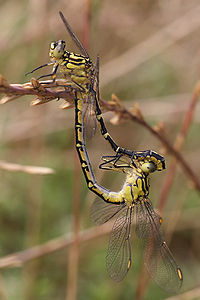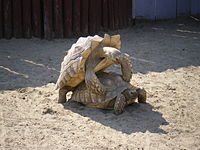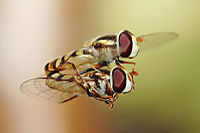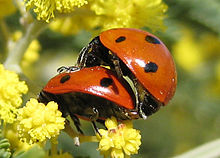- Mating
-
Chlosyne lacinia butterflies mating on a flower
 Mating pair of Laothoe populi moths
Mating pair of Laothoe populi moths For the 1991 American novel, see Mating (novel).
For the 1991 American novel, see Mating (novel).In biology, mating is the pairing of opposite-sex or hermaphroditic organisms for copulation. In social animals, it also includes the raising of their offspring. Copulation is the union of the sex organs of two sexually reproducing animals for insemination and subsequent internal fertilization. The two individuals may be of opposite sexes or hermaphroditic, as is the case with, for example, snails.
For animals, mating methods include random mating, disassortative mating, assortative mating, or a mating pool. In some birds, it includes such behaviours as nest-building and feeding offspring. The human practice of mating domesticated animals and of artificially inseminating them is part of animal husbandry.
Contents
In animals
See also: Animal sexuality and Human sexual activityIn some terrestrial arthropods, including insects representing basal (primitive) phylogenetic clades, the male deposits spermatozoa on the substrate, sometimes stored within a special structure. Courtship involves inducing the female to take up the sperm package into her genital opening without actual copulation. In groups such as dragonflies and many spiders, males extrude sperm into secondary copulatory structures removed from their genital opening, which are then used to inseminate the female (in dragonflies, it is a set of modified sternites on the second abdominal segment; in spiders, it is the male pedipalps). In advanced groups of insects, the male uses its aedeagus, a structure formed from the terminal segments of the abdomen, to deposit sperm directly (though sometimes in a capsule called a "spermatophore") into the female's reproductive tract.
Other animals reproduce sexually with external fertilization, including many basal vertebrates. Vertebrates (such as reptiles, some fish, and most birds) reproduce with internal fertilization through cloacal copulation (see also hemipenis), while mammals copulate vaginally.
For some animals, copulation may or may not be related to reproduction; for example chimpanzees and especially bonobos are known to copulate when the female is not fertile, presumably for pleasure, which in turn strengthens social bonds. See also sexual intercourse and human sexual behavior.
In plants and fungi
See also: Plant sexualityLike in animals, mating in other Eukaryotes, such as plants and fungi, denotes sexual conjugation. However, in vascular plants this is mostly achieved without physical contact between mating individuals (see pollination), and in some cases, e.g., in fungi no distinguishable male or female organs exist (see isogamy); however, mating types in some fungal species are somewhat analogous to sexual dimorphism in animals, and determine whether or not two individual isolates can mate.
See also
- Breeding in the wild
- Sexual intercourse
- Taxa specific
- General
- Animal husbandry
- Animal sexuality
- Biological attraction
- Bisexuality
- Evolution of sex
- Heterosexuality
- Homosexuality
- Lordosis behavior
- Mating system
- Reproduction
- Sex determination system
- Sexual arousal
- Sexual conflict
External links
 Media related to Animal sex at Wikimedia Commons
Media related to Animal sex at Wikimedia Commons
Wikimedia Foundation. 2010.






